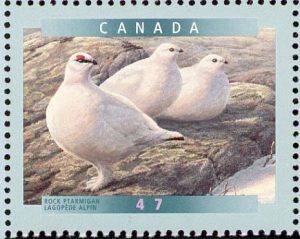Nunavut
Provincial Birds: Rock Ptarmigan (Lagopus mutus)
Nunavut has adopted the Rock Ptarmigan as its Official Territorial bird, as is explicitly stated on the website of the Nunavut Legislative Assembly. The Assembly provides helpful background on the Rock Ptarmigan, including:
“While most other birds migrate south in the early fall, the Rock Ptarmigan (Lagopus Muta) is truly an arctic bird, living in Nunavut throughout the year. Called Aqiggiq in Inuktitut, the rock ptarmigan is found throughout the circumpolar world, earning a place in the art, folklore and diet of indigenous peoples.Distinct from most other birds with its three variations of plumage instead of the usual two, the rock ptarmigan faces its biggest challenge to survival in the winter, when snow and wind conditions make food and shelter hard to find.

eBird Canada has the following to say about the Rock Ptarmigan, in particular focusing on the staged evolution of the plumage as the seasons change:“Plumage changes strikingly throughout the year. In winter, both sexes are pure white with black outer tail feathers. As summer progresses, male develops cold grayish-brown feathers on head, neck, and back; generally, quite splotchy looking. Summer female is paler golden-brown with intricate black and white markings.
eBird also states that in winter, the male Rock Ptarmigan has a distinctive black eyeline, which helps distinguish this bird from the Willow Ptarmigan which doesn’t share this winter feature.
As regards the range of the Rock Ptarmigan, eBird shows that it can be found in northern parts of North America, from Alaska, Yukon, the Northwest Territory as well as Nunavut, then across to Newfoundland and Labrador. Outside North America, the Rock Ptarmigan is present in Greenland, Iceland, Scotland, Norway, Sweden and Finland, with outposts in Russia.




